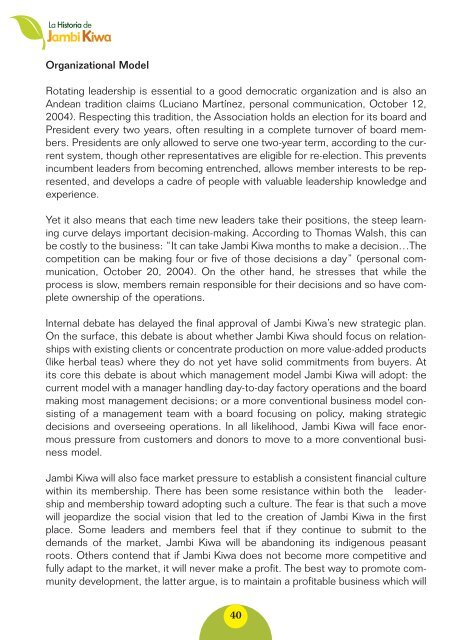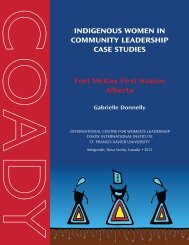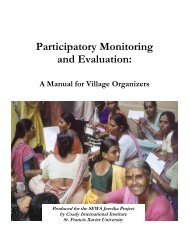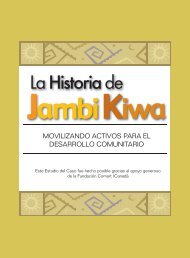Rosa's Story - Coady International Institute - St. Francis Xavier ...
Rosa's Story - Coady International Institute - St. Francis Xavier ...
Rosa's Story - Coady International Institute - St. Francis Xavier ...
You also want an ePaper? Increase the reach of your titles
YUMPU automatically turns print PDFs into web optimized ePapers that Google loves.
Organizational Model<br />
Rotating leadership is essential to a good democratic organization and is also an<br />
Andean tradition claims (Luciano Martínez, personal communication, October 12,<br />
2004). Respecting this tradition, the Association holds an election for its board and<br />
President every two years, often resulting in a complete turnover of board members.<br />
Presidents are only allowed to serve one two-year term, according to the current<br />
system, though other representatives are eligible for re-election. This prevents<br />
incumbent leaders from becoming entrenched, allows member interests to be represented,<br />
and develops a cadre of people with valuable leadership knowledge and<br />
experience.<br />
Yet it also means that each time new leaders take their positions, the steep learning<br />
curve delays important decision-making. According to Thomas Walsh, this can<br />
be costly to the business: “It can take Jambi Kiwa months to make a decision…The<br />
competition can be making four or five of those decisions a day” (personal communication,<br />
October 20, 2004). On the other hand, he stresses that while the<br />
process is slow, members remain responsible for their decisions and so have complete<br />
ownership of the operations.<br />
Internal debate has delayed the final approval of Jambi Kiwa’s new strategic plan.<br />
On the surface, this debate is about whether Jambi Kiwa should focus on relationships<br />
with existing clients or concentrate production on more value-added products<br />
(like herbal teas) where they do not yet have solid commitments from buyers. At<br />
its core this debate is about which management model Jambi Kiwa will adopt: the<br />
current model with a manager handling day-to-day factory operations and the board<br />
making most management decisions; or a more conventional business model consisting<br />
of a management team with a board focusing on policy, making strategic<br />
decisions and overseeing operations. In all likelihood, Jambi Kiwa will face enormous<br />
pressure from customers and donors to move to a more conventional business<br />
model.<br />
Jambi Kiwa will also face market pressure to establish a consistent financial culture<br />
within its membership. There has been some resistance within both the leadership<br />
and membership toward adopting such a culture. The fear is that such a move<br />
will jeopardize the social vision that led to the creation of Jambi Kiwa in the first<br />
place. Some leaders and members feel that if they continue to submit to the<br />
demands of the market, Jambi Kiwa will be abandoning its indigenous peasant<br />
roots. Others contend that if Jambi Kiwa does not become more competitive and<br />
fully adapt to the market, it will never make a profit. The best way to promote community<br />
development, the latter argue, is to maintain a profitable business which will<br />
40








